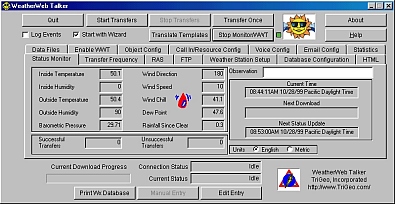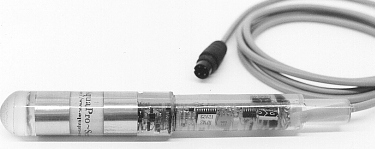Price Quotes
1 888 508-7375
Email
|
|
 |
Autumn 1999
|
|
 |
St. Helens Marina, Oregon
On-site Weather Information Adds Value
|
|
Owners of the St. Helen's Marina have increased the value of their facility's services by providing on-site weather information for tenants and customers.
Convenient Facilities
The St. Helen's Marina is strategically located on the Columbia River west of Portland, Oregon. Situated along 900 feet of waterfront, the marina houses about 200 boats and comprises a fueling facility, RV park, and marina store. There is a repair yard conveniently situated next door. The marina has had a Capricorn II Plus for about two years.
Broadcast Weather Information Not Adequate
If it wasn't for the on-site weather station, the marina's only other source of weather information would be marine weather radio broadcasts. "They do have continuous marine weather, but they don't broadcast this area's information continuously," explains Bob Hendrickson, who owns and operates the marina with his fiance Robin Lillebo.
"When the Coast Guard puts out their marine weather forecasts, you'll get one for Astoria and one for Portland. With us being 30 miles away from Portland, their forecast doesn't tell us what it's doing here. For example, we get different wind directions. So we don't have another accurate source. There is a small airport nearby in Scappoose, but there is nobody that mans it to give us the information."
Wind and Humidity Are Important
"About half our boats are sail boats," says Hendrickson. "Of course wind speed and direction are very important to sail boats. We'll get several calls a day from guys wanting to come down and play, and they can't play unless there is enough wind."
Relative humidity is an important factor in exterior maintenance for the boats. "Almost all the labels on the paint cans will give you some information about the weather that you have to have before you can use it," Hendrickson explains. "So many of our exotic finishes require 60 [percent RH] or below to stay on. Otherwise, as they're drying they pick up a little bit of the humidity in the air. Then instead of a nice shiny finish, they dry to a dull milky finish and that means you have to start over again."
Capricorn Is Easy to Read
One of Hendrickson's favorite features of the Capricorn II Plus is its size. "It's easy to read," he says. "It's attractive - you can see it. It isn't a little tiny thing that you have to get right next to. Right now it's sitting about 20 feet from me and I can read everything. That's nice."
Expanding and Improving
St. Helen's Marina is in expansion mode. Along with on-site weather information, they are improving their facility by adding 50 large slips, additional units in the RV park, and doubling the size of the marina store. "We're also going to add a few floating cabins to rent," Hendrickson concludes. Rumor has it that the first one is earmarked as a wedding gift for his bride-to-be. It will be a nice change from the boat he lives on now.
|
|
|
Weather Watching:
Reliable Weather Information Vital to Safe Boating
|

by George Miller, Consulting Meteorologist
My brother-in-law is one of those devout boaters. His boat is moored at a marina in Tacoma, Washington. He has taken his boat over much of Puget Sound and into the Strait of Georgia. We have had some interesting discussions regarding the weather in those areas. Gene never fails to check the weather before he departs. His marina has an anemometer as do many other marinas in the area. He is what you might call "weather conscious."
And well he should be. Weather, as we all know, varies considerably from one location to another. Local effects such as islands, straits, narrow passageways, hills, etc., disrupt the wind flow, even causing it to blow contrary to the direction it should be blowing, which is from high pressure to low pressure.
To get an accurate picture of the wind flow, an anemometer would have to be placed at locations less than one mile apart. We know that is not feasible, so what one must do is take a report from a reliable location and apply that report into areas nearby. Experience plays a major part. Even though the wind may be different at some other location, given the same meteorological situation, there should be some correlation.
Let's say you start out from Marina A with a certain wind speed and direction. If the meteorological situation is not changing rapidly, what you encounter at Point B should be what you encounted on a previous trip, given the same conditions. So the report from the marina where you started is vital to having a safe boating trip. That's why most marinas employ the use of reliable weather systems such as the Capricorn.
I've taught Gene a little about the weather. He checks it before he departs. Now what I would like to do is teach him where all those fish are. That is going to be a little more difficult.
|
|
|
Software Development:
New WeatherWeb Talker Gives Voice to Capricorn
|

With the latest WeatherWeb Talker, you can call your Capricorn 2000 weather station to check for current conditions, or have it call you to alert you to alarm conditions such as dropping temperatures or high wind speeds. You, your friends, and/or customers can find out what the weather is doing at the marina, on the farm, or anywhere else your Capricorn 2000 weather station is located, simply by calling it on the phone!
Developed by TriGeo, WeatherWeb Talker is a full-service software program that brings voice synthesis to your Capricorn 2000 weather station. "WeatherWeb Talker turns your computer into a two-way communication device that literally speaks your weather - and more," says Kay Wolf Meyer, TriGeo Director of Marketing. "It offers graphing and data storage of historical weather patterns as well."
Built-in wizards make set-up and configuration easy for all levels of computer users.
"Let's say you want to know when the weather drops, say, five degrees," explains TriGeo co-founder Barbara Ueckert. "Simply give that instruction to your PC, and the WeatherWeb Talker will phone you at the exact moment of the drop.What if you're not home to get the call? Just tell your computer to call your mobile phone or pager. It's a great product with dozens of applications. Some are for work, and some could be for just fun."
With an unlimited vocabulary voice synthesis, WeatherWeb Talker can call and/or email a list of contacts with your customized weather message including current weather, business hours, and your advertising message. Other imaginative uses include weather wake-up calls, reminder services, and business "on-hold" message systems.
|
|
|
Product Update:
New Version Soil Moisture Sensor
|

We are proud to introduce our new soil moisture sensor. Combining the affordability of our previous version with the need for broader coverage, this new technology provides the average moisture of a soil volume approximately five cubic inches.
Soil moisture is reported as a percentage - 100 percent being saturated. Sensors can be connected to a hand-held meter or to the Capricorn 2000 weather station for continuous monitoring.
The sensor emits high frequency oscillations to measure the dielectric coefficient (capacitance) of the soil. Since the dielectric coefficient of water is 80 and soil ranges 5 to 10, there is a significant dielectric response in soil with varying moisture content.
The sensor is .87 inches in diameter and 6.25 inches long, with an additional 1.25-inch tapered end to fit the inside diameter of half-inch PVC irrigation pipe for a handle or to aid in installation.
Two versions of the sensor are available. With the portable version, one inch diameter acrylic tubes (supplied in three-foot lengths) are installed in the soil at various locations. The sensor is lowered into each tube allowing measurements to be taken at various depths in any number of zones. Caps are provided to keep water out of the tubes when the sensor is removed.
The second version is a buriable sensor. It has a section of acrylic tubing permanently attached to the sensing area with waterproof adhesive. This will allow the sensor to be buried in a specific location for long-term monitoring and control applications.
With either version, an optional Solenoid Valve Control Interface allows the soil moisture sensor to control irrigation through a standard 24 volt AC irrigation controller.
Connected to the Capricorn 2000, soil moisture data can be used for decision making, historical data, and correlation with other weather parameters such as rainfall, soil and air temperatures, and solar radiation.
Prices
Soil moisture sensor: $300.00
Hand-held moisture meter: $397.50
Solenoid valve interface: $115.00
|
|
|

